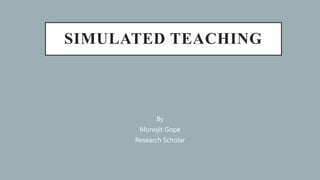
Simulated Teaching.pptx
- 1. SIMULATED TEACHING By Monojit Gope Research Scholar
- 2. INTRODUCTION The development of simulated teaching can be traced back to the early 1960s, when Donald Cruickshank, a professor of education at the University of Iowa, developed a method of simulated teaching called microteaching. Microteaching involves breaking down a teaching lesson into small segments, or "micro-units," and then practicing each micro-unit in front of a small group of peers. This allows teachers to get feedback on their teaching skills in a safe and supportive environment.
- 3. WHAT IS SIMULATED TEACHING? Simulated teaching is a teaching method in which students practice teaching in a simulated environment. This can be done using a variety of methods, such as role-playing, video games, or computer simulations.
- 4. HISTORY OF THE TERM The term “Simulated Teaching” was first introduced by Donald Cruickshank in 1968. He developed this method as a way to help teacher trainees develop their teaching skills in a safe and supportive environment. Cruickshank believed that simulated teaching could help trainees to learn about different teaching methods and strategies, and to develop their confidence and self-efficacy as teachers.
- 5. TERMS USED • Simulated Teaching is a method of teacher training developed by Donald R Cruickshank in 1968. It is also known by several other terms like Role Playing. Artificial Teaching. Pilot Training. Laboratory method. Clinical Method. Inductive Scientific Method.
- 6. STAGES OF SIMULATED TEACHING • Cruickshank’s method of simulated teaching involved three stages: Preparation: In this stage, trainees would prepare a lesson plan and practice their teaching skills in front of a mirror or a small group of peers. Performance: In this stage, trainees would teach a lesson to a group of students. This would be done in a simulated classroom setting, with the trainees being observed by their peers and a supervisor. Feedback: In this stage, the trainees would receive feedback on their teaching performance from their peers and the supervisor. This feedback would be used to help the trainees to improve their teaching skills.
- 7. WHY USE SIMULATED TEACHING? There are several reasons why teachers might use simulated teaching. For one, it can help students develop their teaching skills in a safe and supportive environment. Simulated teaching can also help students to learn about different teaching methods and strategies. Additionally, simulated teaching can help students to develop their confidence and self-efficacy as teachers.
- 8. HOW TO USE SIMULATED TEACHING • There are many different ways to use simulated teaching. Here are a few examples: Role-playing: In role-playing, students take on the roles of teachers and students. This can be done in a small group setting or in a large group setting. Video games: There are a number of video games that allow students to practice teaching. These games can be used to teach a variety of subjects, such as math, science, and reading. Computer simulations: Computer simulations can be used to create realistic teaching environments. These simulations can be used to teach a variety of subjects, such as math, science, and social studies.
- 9. BENEFITS OF SIMULATED TEACHING • There are many benefits to using simulated teaching. Here are a few of the most important benefits: Safe and supportive environment: Simulated teaching provides a safe and supportive environment for students to practice teaching. This is important because it allows students to make mistakes without fear of judgment. Learning about different teaching methods and strategies: Simulated teaching can help students to learn about different teaching methods and strategies. This can be helpful for students who are new to teaching or who are looking for new ways to improve their teaching. Developing confidence and self-efficacy: Simulated teaching can help students to develop their confidence and self-efficacy as teachers. This is important because it can help students to feel more comfortable and confident in their teaching abilities.
- 10. CONCLUSION Simulated teaching is a valuable teaching method that can help students to develop their teaching skills in a safe and supportive environment. Simulated teaching can also help students to learn about different teaching methods and strategies, and to develop their confidence and self-efficacy as teachers.
- 11. THANK YOU
